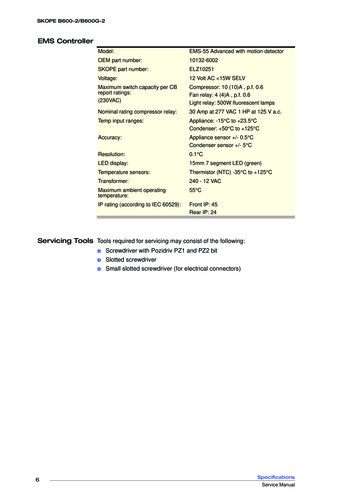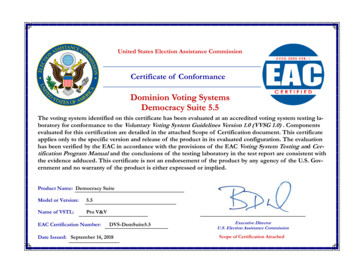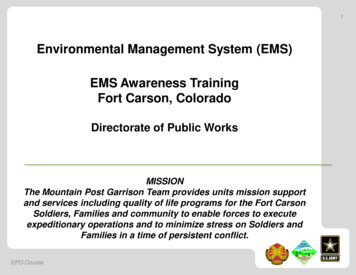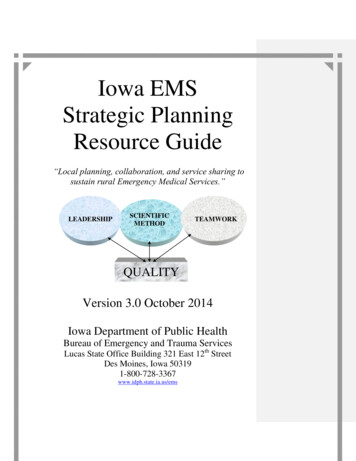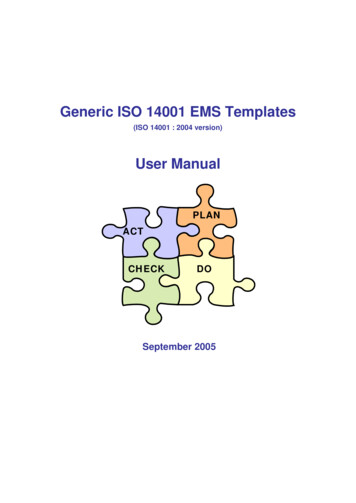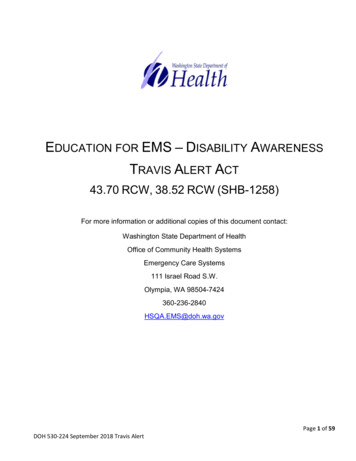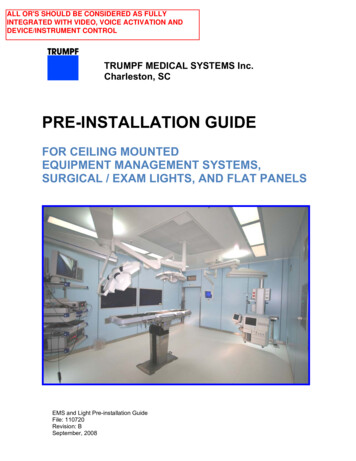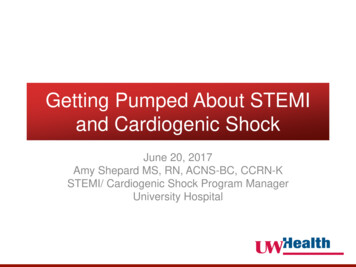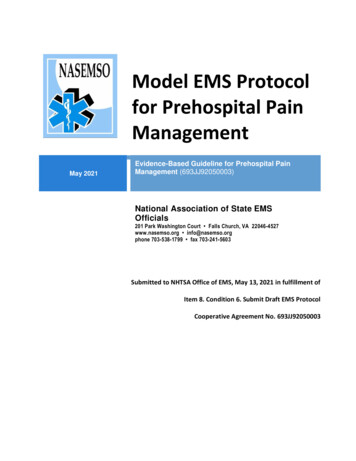
Transcription
Model EMS Protocolfor Prehospital PainManagementMay 2021Evidence-Based Guideline for Prehospital PainManagement (693JJ92050003)National Association of State EMSOfficials201 Park Washington Court Falls Church, VA 22046-4527www.nasemso.org info@nasemso.orgphone 703-538-1799 fax 703-241-5603Submitted to NHTSA Office of EMS, May 13, 2021 in fulfillment ofItem 8. Condition 6. Submit Draft EMS ProtocolCooperative Agreement No. 693JJ92050003
Pain Management(Incorporates elements of an evidence-based guideline for prehospital analgesia in trauma and evidencebased guidelines for prehospital pain management created using the National Prehospital EvidenceBased Guideline Model Process)AliasesAnalgesia, pain control, acute pain, acute traumatic pain, acute atraumatic painPatient Care GoalsThe practice of prehospital emergency medicine requires expertise in a wide variety of pharmacologicaland non-pharmacological techniques to treat acute pain resulting from myriad injuries and illnesses.Approaches to pain relief must be designed to be safe and effective in the dynamic prehospitalenvironment. The degree of pain and the hemodynamic status of the patient will determine the urgencyand extent of analgesic interventions.Patient PresentationInclusion CriteriaPatients who are experiencing painExclusion Criteria1. Pregnancy with active labor2. Patients with care-plans that prohibit use of parenteral analgesics by EMSPatient ManagementAssessment, Treatment, and Interventions1. Determine patient’s pain score assessment using standard pain scale.a. Less than 4 years old: Observational scale (e.g. Faces, Legs, Arms, Cry, Consolablity[FLACC] or Children’s Hospital of Eastern Ontario Pain Scale (CHEOPS)b. 4-12 years old: Self-report scale (e.g. Wong Baker Faces, Faces Pain Scale [FPS],Faces Pain Scale Revised [FPS-R])c. Greater than 12 years old: Self-report scale (Numeric Rating Scale [NRS])2. Consider initial use of non-pharmaceutical pain management techniquesa. Placement of the patient in a position of comfortb. Application of ice packs and/or splints for pain secondary to traumac. Verbal reassurance or distraction to minimize anxietyd. For children, caregiver presence to the degree allowed by required clinical care andcaregiver comfort3. If non-pharmaceutical techniques are not sufficient to relieve pain, then consider use ofnon-IV analgesicsa. PO options (for milder pain with the understanding that onset of action will be slower thanIN/IM/IV or if there is a desire to avoid parenteral medications and/or opioids)i. Acetaminophen 15 mg/kg PO (maximum dose 1 g)ii. Ibuprofen 10 mg/kg PO for patients greater than 6 months of age (maximumdose 800 mg)b. Intranasal (IN) options (preferred as initial dosing, particularly in children, to initiate painSubmitted to NHTSA OEMS May 13, 2021Cooperative Agreement # 693JJ92050003
relief prior to, or in the absence of, IV access. IN administration may obviate the need toobtain IV access for pain medication)i. Fentanyl 1 mcg/kg INii. Ketamine: 0.5 mg/kg IN (maximum initial dose 25 mg; maximum cumulative dose100 mg)c. Intramuscular (IM) optionsi. Ketorolac (one-time dose only) Adult (non-pregnant): 30 mg IM Pediatric (2-16 years old): 1 mg/kg IM (maximum dose 30 mg)ii. Morphine sulfate: 0.1 mg/kg IM (maximum initial dose 15 mg)iii. Fentanyl 1 mcg/kg (maximum initial dose of 100 mcg)d. Inhaled: nitrous oxide4. Establish IV access if there is ongoing pain warranting further treatment and administer one ofthe following:a. Acetaminophen:i. Adult: 1 g IVii. Pediatric: 15 mg/kg IV (maximum dose 1 g)b. Ketorolac (one-time dose only):i. Adult: 15 mg IV in adults who are not pregnantii. Pediatric (2-14 years old): 0.5mg/kg (maximum dose 15 mg) IVc. Fentanyl:i. Adult: 25-50 mcg IVii. Pediatric: 1 mcg/kg IV (maximum initial dose 100 mcg)d. Morphine sulfate:i. Adult: 5 mg IVii. Pediatric: 0.1 mg/kg IV (maximum initial dose 5 mg)e.Hydromorphone:i. Adult: 1-2 mg IVii. Pediatric: 0.015 mg/kg IV (maximum initial dose 2 mg; maximumcumulative dose of 4 mg)f. Ketamine:i. Adult: 25 mg IV (slow IV push or infusion in 100 cc NS/LR)ii. Pediatric: 0.25 mg/kg IV (maximum initial dose 25 mg; maximum cumulativedose 100mg)5. Consider administration of oral, sublingual, or IV anti-emetics to prevent nausea in highrisk patients [see Nausea/Vomiting guideline]6. If indicated based on pain assessment, and vital signs allow, may repeat painmedication administration every 15 minutes (to maximum recommended dose)(excluding ketorolac, ibuprofen, and acetaminophen)Submitted to NHTSA OEMS May 13, 2021Cooperative Agreement # 693JJ92050003
7. Transport in position of comfort and reassess as indicateFrom: Odhner M, Wegman D, Freeland N, Ingersoll G. Evaluation of a newlydeveloped non-verbal pain scale (NVPS) for assessment of pain in sedatedcritically ill patients.Available at: http://www.aacn.org /AACN/NTIPoster.nsf/vwdoc/2004NTI Posters.Accessed July 18, 2017.Submitted to NHTSA OEMS May 13, 2021Cooperative Agreement # 693JJ92050003
Universal Pain Assessment ToolVerbalDescriptorScaleNo PainMildPainModeratePainSevere PainVery SeverePainExcruciatingPainWongBakerFACES rowedBrowPursed LipsBreathHoldingWrinkledNoseEyes ClosedRaised UpperLipSlow BlinkMoaningOpen MouthCryingRapidBreathingActivityToleranceScaleNo PainCan beIgnoredInterfereswith TasksInterfereswithConcentrationInterferes withBasic NeedsBed RestRequiredSpanishNada deDolorUnPoquitodeDolorUn Dolor LeveDolor FuerteDolorDesmasiadoFuerteUn DolorInsoportableSource: Hybrid of scales by authors. Wong-Baker FACES Pain Scale Rating license grants this use.Reproduction of the Wong-Baker FACES material requires licensing at www.wongbakerfaces.org.Submitted to NHTSA OEMS May 13, 2021Cooperative Agreement # 693JJ92050003
Pediatric-Appropriate Pain Assessment ToolsFaces, Legs, Activity, Cry, Consolability (FLACC) Behavioral ScaleAppropriate age for use (per guideline): less than 4 yearsCategoriesFace (F)Legs (L)Activity (A)Cry (C)0No particularexpression or smileScoring1Occasional grimaceor frown, withdrawn,disinterestedNormal position orrelaxedLying quietly, normalposition, moves easilySquirming, shifting backand forth, tenseNo cry (awakeor asleep)Moans or whimpers,occasional complaintUneasy, restless, tense2Frequent to constantfrown, clenched jaw,quivering chinKicking, or legsdrawn upArched, rigid,or jerkingCrying steadily,screams or sobs,frequent complaintsReassured by occasionaltouching, hugging,Difficult to console orContent, relaxedor being talked to,comfortdistractibleEach of the five categories is scored from 0-2, which results in a total score between zero andten.Consolability(C) 2002, The Regents of the University of Michigan. All Rights Reserved.Instructions: Patients who are awake: Observe for at least 1-2 minutes. Observe legs and body uncovered.Reposition patient or observe activity, assess body for tenseness and tone. Initiate consolinginterventions, if needed Patients who are asleep: Observe for at least 2 minutes or longer. Observe body and legsuncovered. If possible, reposition the patient. Touch the body and assess for tenseness andtone.Face Score 0 point if patient has a relaxed face, eye contact and interest in surroundingsScore 1 point if patient has a worried look to face, with eyebrows lowered, eyes partially closed,cheeks raised, mouth pursedScore 2 points if patient has deep furrows in the forehead, with closed eyes, open mouth anddeep lines around nose/lipsLegs Score 0 points if patient has usual tone and motion to limbs (legs and arms)Score 1 point if patient has increase tone, rigidity, tense, intermittent flexion/extension of limbsSubmitted to NHTSA OEMS May 13, 2021Cooperative Agreement # 693JJ92050003
Score 2 points if patient has hyper tonicity, legs pulled tight, exaggerated flexion/extensionof limbs, tremorsActivity Score 0 points if patient moves easily and freely, normal activity/restrictionsScore 1 point if patient shifts positions, hesitant to move, guarding, tense torso, pressure on bodypartScore 2 points if patient is in fixed position, rocking, side-to-side head movement, rubbing bodypartCry Score 0 points if patient has no cry/moan awake or asleepScore 1 point if patient has occasional moans, cries, whimpers, sighsScore 2 points if patient has frequent/continuous moans, cries, gruntsConsolability Score 0 points if patient is calm and does not require consolingScore 1 point if patient responds to comfort by touch or talk in ½ - 1 minuteScore 2 points if patient require constant consoling or is unconsoled after an extended timeWhenever feasible, behavioral measurement of pain should be used in conjunction with self-report.When self-report is not possible, interpretation of pain behaviors and decision-making regardingtreatment of pain requires careful consideration of the context in which the pain behaviors wereobserved.Each category is scored on a 0-2 scale, which results in a total score of 0-10Assessment of Behavioral Score:0 Relaxed and comfortable1-3 Mild discomfort4-6 Moderate pain7-10 Severe discomfort/pain 2002, The Regents of the University of Michigan. All Rights Reserved.Source: The FLACC: A behavioral scale for scoring postoperative pain in young children, by S Merkel andothers, 1997, Pediatr Nurse 23(3), p. 293–297.Submitted to NHTSA OEMS May 13, 2021Cooperative Agreement # 693JJ92050003
Faces Pain Scale – Revised (FPS-R)In the following instructions, say "hurt" or "pain", whichever seems right for a particular child. "Thesefaces show how much something can hurt. This face [point to face on far left] shows no pain. The facesshow more and more pain [point to each from left to right] up to this one [point to face on far right] - itshows very much pain. Point to the face that shows how much you hurt [right now]."Score the chosen face 0, 2, 4, 6, 8, or 10, counting left to right, so “0” “no pain” and “10” “very muchpain”. Do not use words like “happy” or “sad.” This scale is intended to measure how children feelinside, not how their face looks.Permission for Use. Copyright of the FPS-R is held by the International Association forthe Study of Pain (IASP) 2001. This material may be photocopied for non-commercial clinical,educational and research use. For reproduction of the FPS-R in a journal, book or web page, or for anycommercial use of the scale, request permission from IASP online at www.iasp-pain.org/FPS-R.Patient Safety Considerations1. All patients should be questioned regarding allergies to pain medications prior to administration2. Avoid opioids with patients with GCS less than 15, hypotension, hypoxia (oxygen saturationless than 90%) after supplemental oxygen therapy, or signs of hypoventilation3. Opioids are contraindicated for patients who have taken monoamine oxidase inhibitors(MAOIs – e.g. Nardil , Parnate , Azilect , Marplan , Eldepryl ) during the previous 14 days4. Avoid non-steroidal anti-inflammatory medications such as ketorolac and ibuprofen inpatients with NSAID allergy, aspirin-sensitive asthma, renal insufficiency, pregnancy, orknown peptic ulcer disease5. Ketorolac and ibuprofen should not be used in patients with hypotension (due to renaltoxicity)6. Use of splinting techniques and application of ice should be done to reduce the totalamount of medication used to keep the patient comfortableNotes/Educational PearlsKey Considerations1. Pain severity (using scales outlined above) should be recorded before andregularly (i.e., every 15 minutes) after analgesic medication administration andupon arrival at destination2. For the initial management of moderate to severe pain, IV acetaminophen ispreferred over IV opioids, when available, to minimize adverse side effects3. Patients with acute abdominal pain may safely receive analgesic medications asneeded for comfort – Use of analgesics for acute abdominal pain does not maskclinical findings or delay diagnosisSubmitted to NHTSA OEMS May 13, 2021Cooperative Agreement # 693JJ92050003
4. Combining ketamine with opiates does not provide added analgesic benefit and addscomplexity and increased risk for adverse effects and errors and errors in administration5. Pediatric Considerations: IN medications (fentanyl/ketamine) are preferred over IV/IM forpediatrics to potentially avoid the need for IV access for pain medication administrationPertinent Assessment Findings1. Mental status (GCS/AVPU)2. Pain level (based on appropriate age-based scales)3. Respiratory system (respiratory rate, pulse oximetry, ETCO2)Quality ImprovementAssociated NEMSIS Protocol(s) (eProtocol.01) 9914071 – General-Pain ControlKey Documentation Elements Documentation of patient vital signs with pulse oximetry Acquisition of patient’s allergies prior to administration of medication Documentation of initial patient pain scale assessment Documentation of medication administration with correct dose Documentation of patient reassessment with repeat vital signs and patient pain scaleassessmentPerformance Measures The clinical efficacy of prehospital analgesia in terms of adequacy of dosing parameters NEMSQA Measures (for additional information, see www.nemsqa.org/completed-qualitymeasures/o PEDS-03: Documentation of estimated weight in kilograms. Frequency that weight orlength-based estimate are documented in kilogramso Trauma-01: Pain assessment of injured patients. Recognizing that pain is undertreated ininjured patients, it is important to assess whether a patient is experiencing paino Trauma-03: Effectiveness of pain management in injured patients.Recognizing that pain is undertreated in injured patients, it is important toassess whether a patient’s pain is being reduced by EMS during transportReferences1. Attard AR, Corlett MJ, Kidner NJ, Leslie AP, Fraser IA. Safety of early pain relief for acuteabdominal pain. BMJ. 1992;305(6853):554-6.2. Bieri D, Reeve R, Champion GD, Addico at L, Ziegler J. The Faces Pain Scale for the selfassessment of the severity of pain experienced by children: Development, initialvalidation and preliminary investigation for ratio scale properties. Pain 1990;41:139-150.3. Brewster GS, Herbert ME. Hoffman JR. Medical myth: analgesia should not be given topatients with acute abdominal pain because it obscures the diagnosis. West J Med.2000;172(3):209-10.4. Prehospital use of Ketamine in Battlefield Analgesia 2012-13. Falls Church, VA: DefenseHealth Agency; March 8, 2012. Correspondence to Assistant Secretary of Defense (HealthAffairs).5. Hicks CL, von Baeyer CL, Spafford P, van Korlaar I, Goodenough B. The Faces Pain Scale –Revised: Toward a common metric in pediatric pain measurement. Pain. 2001;93:173-83.Submitted to NHTSA OEMS May 13, 2021Cooperative Agreement # 693JJ92050003
6. Jennings PA, Cameron P, Bernard S. Ketamine as an analgesic in the pre-hospital setting: asystematic review. Acta Anaesthsiol Scand. 2011;55(6):638-43.7. LoVecchio F, Oster N, Sturmann K, Nelson LS, Flashner S, Finger R. The use of analgesics inpatients with acute abdominal pain. J Emerg Med. 1997;15(6):775-9.8. Manterola C, Astudillo P, Losada H, Pineda V, Sanhueza A, Vial M. Analgesia in patients withacute abdominal pain. Cochrane Database Syst Rev. 2007 Jul 18;(3)CD005660.9. Merkel S, e al. The FLACC: A behavioral scale for scoring postoperative pain in youngchildren., Pediatr Nurse. 1997;23(3):293–7.10. Sonmez D, Caglar S. The effect of parental presence on pain and anxiety levelsduring invasive procedures in the pediatric emergency department. J Emerg Nurs.2019;45:278-285.11. Ranji SR, Goldman LE, Simel DL, Shojania KG. Do opiates affect the clinical evaluation ofpatients with acute abdominal pain? JAMA. 2006;296(14):1764-74.12. Svenson JE, Abernathy MK. Ketamine for prehospital use: new look at an old drug. Am J EmergMed. 2007;25:977-80.13. Wiel E, Zitouni D, Assez N, et al. Continuous infusion of ketamine for out-of-hospital isolatedorthopedic injuries secondary to trauma: a randomized controlled trial. Prehosp Emerg Care.2015;19(1);10-16.14. Wood PR. Ketamine: prehospital and in-hospital use. Trauma. 2003;5(2):137-40.15. Phrampus PE and Paris P. The science of pain. A guide to prehospital pain management. JEMS2016;41(11):53-6.16. Wedmore IS and Butler FK. Battlefield analgesia in tactical combat casualty care. WildernessEnviron Med 2017;28(2S):S109-S116.17. Samuel N, Steiner I, Shavit I. Prehospital pain management of injured children: a systematicreview of current evidence. Am J Emerg Med 2015;33(3):451-4.18. Odhner M, Wegman D, Freeland N, Ingersoll G. Evaluation of a newly developed non-verbalpain scale (NVPS) for assessment of pain in sedated critically ill patients. Available at:http://www.aacn.org /AACN/NTIPoster.nsf/vwdoc/2004NTI Posters. Accessed July 18, 2017.19. Pace S, Burke TF. Intravenous morphine for early pain relief in patients with acuteabdominal pain. Acad Emerg Med. 1996;3(12):1086-92.20. Porter K. Ketamine in prehospital care. Emerg Med J 2004;21:351-4.21. Ranji SR, Goldman LE, Simel DL, Shojania KG. Do opiates affect the clinical evaluation ofpatients with acute abdominal pain? JAMA. 2006;296(14):1764-74.22. Svenson JE, Abernathy MK. Ketamine for prehospital use: new look at an old drug. Am JEmerg Med. 2007;25:977-80.23. Vermuelen B, Morabia A, Unger PF, et al. Acute appendicitis: influence of early pain reliefon the accuracy of clinical and US findings in the decision to operate – a randomized trial.Radiology. 1999;210(3):639-43.24. Wiel E, Zitouni D, Assez N, et al. Continuous infusion of ketamine for out-of-hospital isolatedorthopedic injuries secondary to trauma: a randomized controlled trial. Prehosp Emerg Care.2015;19(1);10-16.25. Wood PR. Ketamine: prehospital and in-hospital use. Trauma. 2003;5(2):137-40.Revision DateMay 31, 2021Submitted to NHTSA OEMS May 13, 2021Cooperative Agreement # 693JJ92050003
1. Determine patient's pain score assessment using standard pain scale. a. Less than 4 years old: Observational scale (e.g. Faces, Legs, Arms, Cry, Consolablity [FLACC] or Children's Hospital of Eastern Ontario Pain Scale (CHEOPS) b. 4-12 years old: Self-report scale (e.g. Wong Baker Faces, Faces Pain Scale [FPS], Faces Pain Scale Revised .
